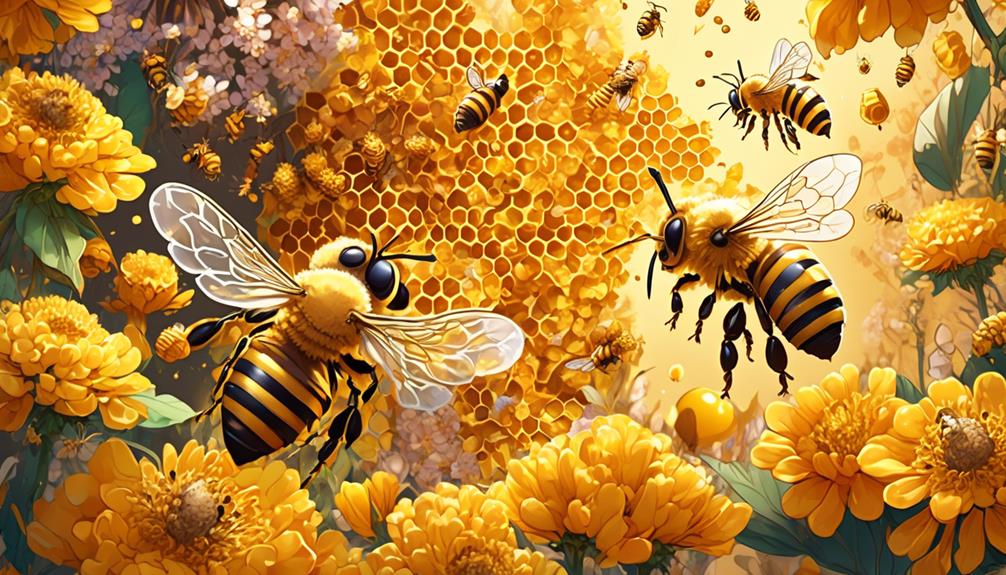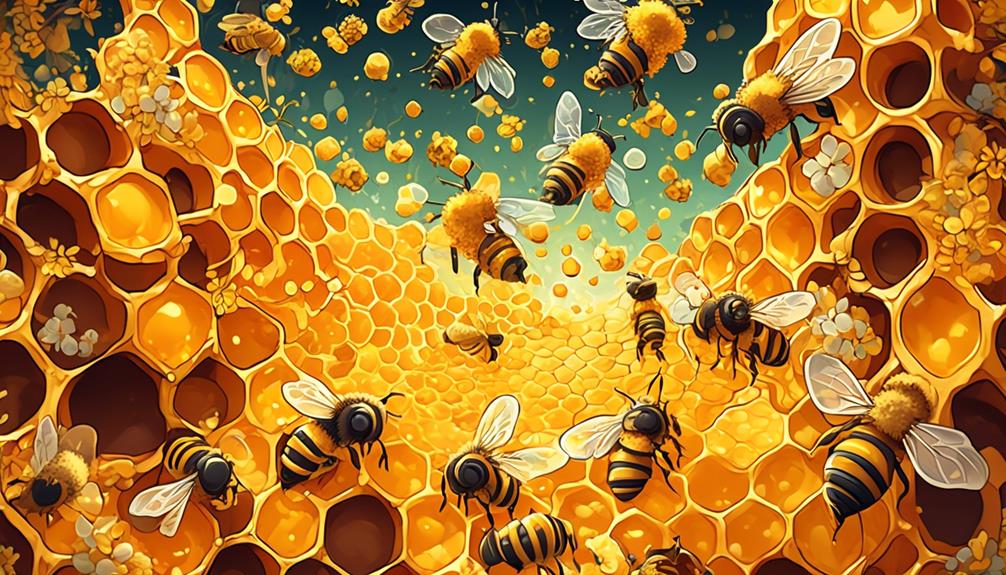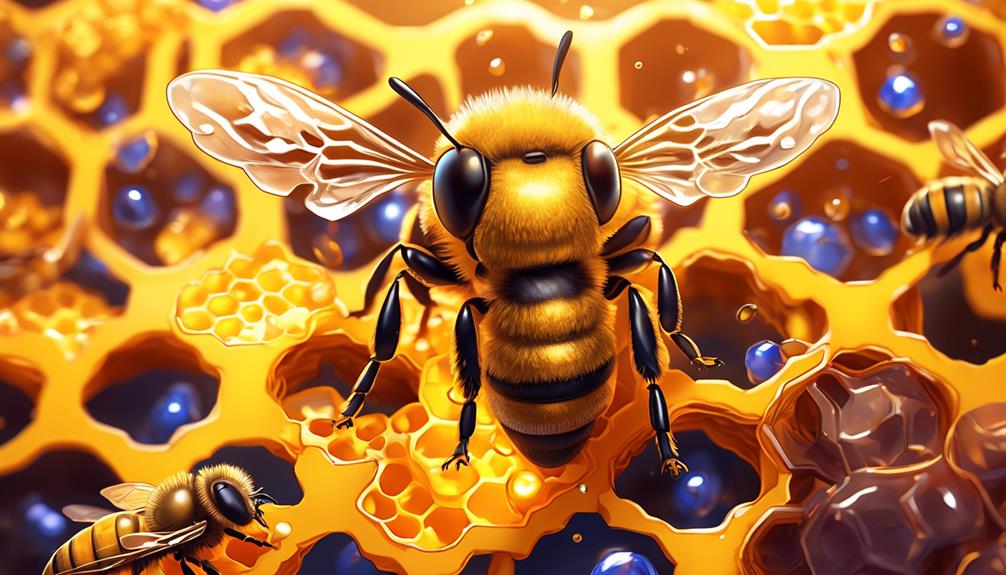Honey or bee poop? Uncover the captivating process behind honey production and debunk common misconceptions in this informative read.

Is Bee Poop Honey?
Just by coincidence, you've probably tasted honey, savored its sweetness, and maybe even used it for its medicinal properties, but have you ever wondered where it comes from?
It's not uncommon for people to think, erringly, that honey is, in fact, bee excrement. This is a common misconception, yet it's far from the truth.
Bees, those small industrious insects, have a quite fascinating and intricate process of producing the golden liquid we know and love. But what exactly is this process? How do bees transform nectar into honey? And most importantly, can we really classify honey as bee poop?
You're about to find out.
Key Takeaways
- Honey is not bee poop, but rather the transformed product of nectar.
- Bees collect nectar from flowers and mix it with enzymes to create honey.
- Honey production involves a process of collecting, transforming, and preserving nectar.
- Honey has various health benefits, such as being rich in antioxidants and having antibacterial properties.
Understanding the Honeybee Anatomy

To truly understand how honey is made, you'll need to delve into the complex anatomy of a honeybee, starting with its three primary body parts: the head, the thorax, and the abdomen.
The head houses the brain, antennae, and a pair of compound eyes. Here, you'll also find the proboscis, a long, flexible tongue used for drinking nectar. The thorax, the bee's power center, comprises three segments, each with a pair of legs. Two pairs of wings are also attached to the thorax.
Your attention should then shift to the abdomen, the site of honey production. It's made up of six segments and contains the digestive system, sting apparatus, and reproductive organs. Of interest is the honey stomach, a specialized organ where nectar is stored and transformed into honey. Enzymes are added to the nectar, breaking down complex sugars into simple ones.
Lastly, it's critical to understand the bee's wax glands. Located in the abdomen, these glands produce wax used to construct the honeycomb. The bee's ability to convert nectar into honey, store it, and create a storage system, is a marvel of nature and a testament to its intricate anatomy.
Misconceptions About Honey Production

Having grasped the intricacies of the honeybee's anatomy and how it contributes to honey production, you might still encounter numerous misconceptions, including the oft-debated question: is honey really bee poop? This is a striking but inaccurate concept. Honey is not bee poop, but rather the end product of nectar processed by honeybees.
Here's a markdown table that breaks down some key misconceptions about honey production:
Misconception | Truth | Explanation |
|---|---|---|
Honey is bee poop | False | Honey is made from nectar, not waste |
Bees make honey for humans | False | Bees make honey for their own food supply |
All bees make honey | False | Only certain species of bees produce honey |
Honey is 'bee vomit' | Partially true | Honey is regurgitated nectar, but not in a 'vomit' sense |
Honey production harms bees | False | Beekeeping, when done responsibly, doesn't harm bees |
Understanding these misconceptions can help you appreciate the complex process of honey production. Honey is a marvel of nature, a product of hardworking bees, and certainly not their waste. Knowing this, you can savor the sweet taste of honey with a newfound respect for the buzzing creatures that produce it.
The Nectar Collection Process

Diving into the nectar collection process, you'll find it's a meticulous task that begins when honeybees set out on a foraging mission to gather this sweet plant fluid. The bees utilize their long, tube-like tongues, known as proboscises, to extract nectar from deep within flowers. Able to visit up to 5,000 flowers in a day, a single bee can collect a bellyful of nectar to transport back to the hive.
Once the nectar is stored within their honey stomachs, enzymes begin to break down its complex sugars into simpler forms. This enzymatic process, crucial to honey production, reduces the water content and transforms the nectar into a substance that's more resistant to spoilage.
Upon returning to the hive, the foraging bees regurgitate the partially digested nectar to hive bees. These hive bees then continue the process, further reducing the water content and adding even more enzymes. This process continues until the nectar evolves into honey.
In essence, the nectar collection process is a laborious, cooperative effort that involves multiple bees and stages, all working in harmony to produce the sweet, golden substance we know as honey.
Transformation: Nectar to Honey

You might be wondering how the transformation from nectar to honey actually occurs within the hive, so let's delve into the fascinating process. Bees collect nectar from flowers, which is mainly comprised of water and complex sugars. Once inside the bee's stomach, the nectar mixes with enzymes that break down the complex sugars into simpler ones. This nectar-enzyme mixture is then passed from bee to bee, further breaking down the sugars.
This transformed nectar is then deposited into the honeycomb cells where the bees use their wings to fan and evaporate the water, thickening the mixture into honey. Once the honey is ripe, the bees seal the honeycomb cell with wax, preserving the honey for later consumption.
Here's a simplified table to help you understand:
Steps | Description |
|---|---|
Collection | Bees collect nectar from flowers |
Transformation | Enzymes in bees' stomachs break down the complex sugars |
Transfer | Nectar-enzyme mixture is passed from bee to bee |
Evaporation | Bees fan the mixture to evaporate water and thicken it into honey |
Preservation | Bees seal the honeycomb cell with wax for preservation |
That's the transformation from nectar to honey, a real marvel of nature.
Health Benefits of Honey

Beyond its sweet taste, honey packs a powerful punch of health benefits that are too significant to ignore. Rich in antioxidants, it's a potent weapon in your fight against chronic diseases. Flavonoids and phenolic compounds, found abundantly in honey, shield your body from oxidative stress, reducing the risk of heart disease and cancer.
Honey's antibacterial and anti-inflammatory properties are equally impressive. It's a natural remedy for wounds, burns, and skin infections. You can apply it topically to accelerate healing and prevent bacterial growth. Its anti-inflammatory effects help to reduce swelling and pain, promoting faster recovery.
The natural sugars in honey serve as a healthier energy source than refined sugar. It's a great option if you're trying to maintain stable blood sugar levels. Plus, it can soothe a sore throat and suppress coughs, making it a staple in many home remedies for colds and flu.
Debunking the Bee Poop Theory

Despite its peculiar origins, it's a common misconception that honey is bee poop; let's debunk this theory.
Honey, in fact, isn't bee feces but the byproduct of nectar consumed by bees. Bees collect nectar from flowers with their long, straw-like tongues and store it in their stomach, referred to as a 'honey stomach'. This is separate from their digestive stomach, so the nectar doesn't mix with their digestive waste.
Once the bee reaches the hive, it regurgitates the nectar into the mouth of a hive bee. This process repeats until the partially digested nectar is deposited into a honeycomb. Enzymes within the bees' stomachs break down the complex sugars in the nectar into simpler ones, creating honey. This honey is then sealed in the honeycomb with a secretion of liquid from the bee's abdomen, which hardens into beeswax.
Bee poop, on the other hand, is a completely separate process. Bees excrete waste, which is typically a yellowish color, away from their hive to keep the colony clean. So, to clarify, honey isn't bee poop, but a sweet product of industrious teamwork.
Frequently Asked Questions
How Do Bees Communicate With Each Other About the Location of Flowers?
Bees communicate about the location of flowers through a unique dance language. When a forager bee finds a good source of nectar, it returns to the hive and performs a 'waggle dance'.
The direction and duration of the dance conveys the direction and distance of the flower source from the hive. Other bees watch the dance, interpret the information, and then fly off to collect nectar.
It's a fascinating method of insect communication.
What Are the Different Types of Honey and How Do They Differ in Taste and Nutritional Value?
No, bee poop isn't honey. Bees collect nectar from flowers, which they transform into honey through a process of regurgitation and evaporation.
The different types of honey – from clover, manuka, acacia, etc. – reflect the variety of flowers bees visit. They vary in taste, color and nutritional value.
For instance, manuka honey's darker color and robust flavor come with more antioxidants than lighter, milder clover honey.
Can Humans Contract Any Diseases or Infections From Consuming Honey?
No, you can't typically contract diseases or infections from consuming honey. It's generally safe for human consumption. Due to its low moisture content and acidic pH, honey is a poor environment for harmful bacteria or viruses.
However, it's not recommended for children under 12 months due to the potential risk of botulism.
Always ensure you're buying from a reputable source, as improperly processed honey can contain harmful contaminants.
Is There Any Risk to the Bee Population Due to Honey Production and Harvest?
No, honey production and harvest don't pose a risk to bee populations if done responsibly. You need to ensure you're not taking all the honey, as bees need some for their survival, especially during winter. Over-harvesting can indeed stress the colony.
Also, avoid using harmful pesticides. Remember, sustainable beekeeping practices promote bee health and protect these crucial pollinators. So, it's in your hands to make a difference.
Are There Any Alternatives to Honey That Have Similar Health Benefits?
You're asking about alternatives to honey with similar health benefits. There are several options you might consider.
Agave nectar, for example, is a sweetener that's often used as a honey substitute. It has anti-inflammatory and immune-boosting properties.
Maple syrup, too, has antioxidants and minerals like zinc and manganese.
Molasses is another choice, which is high in iron and calcium.
Conclusion
In essence, honey isn't bee poop. It's a complex process where bees collect nectar, add enzymes, and reduce moisture content to create the golden elixir. This process, far from being a waste product, is a testament to the remarkable biology of honeybees.
So, next time you savor honey, remember its incredible journey from flower to hive. Not only is it delicious, but it's also packed with health benefits.
So, debunk that bee poop theory and enjoy your honey!

